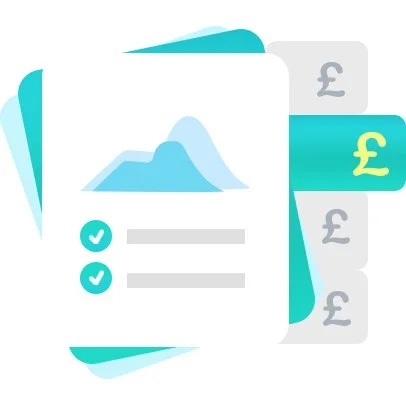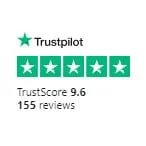
Enquire
Enter your details. It only takes one minute.

Compare
We compare the market to find you the best 3 quotes

Save
You receive your quotes directly from the provider
SME Business Loans April 2024
How Can They Help Your Growing SME?
If you’re a small enterprise or a new start up, you may be finding it confusing to choose the right business finance for your needs. The good news is that securing a great business finance deal doesn’t have to be difficult. Here are 3 aspects that every SME should look for in a small business loan:
- Profit Growth Business profits can be improved through various strategies – most notably through a greater focus on marketing for brand awareness and visibility, through advanced office equipment and professional premises, and through raised prices that reflect an enhanced quality and service. A recent report by British innovation charity Nesta – and backed by research by the University of Cambridge – suggests up to 63 percent of commercial peer-to-peer borrowers in the UK have successfully increased profits as the direct result of suitable and affordable business loans.
- Increased TurnoverThe same Nesta report suggests that around 70 percent of businesses that receive funding through an equity crowdfunding scheme – one of the most popular types of alternative business loans – enjoy increased turnover. This can be reasonably attributed to an improved sales volume through greater sales training, streamlined internal processes, and an expanded capacity for businesses in the service industry. There are, of course, many advantages to an increased turnover, one of the most prominent being compulsory VAT registration which can have a significant impact on business profile.
Business loans are becoming a much more attractive option for SME businesses who have perhaps lacked confidence in the years since the financial crisis. Today’s business loans don’t need to be a high risk endeavour, especially when choosing business loans with low interest rates. Small businesses can identify suitable lenders by using online comparison tools which make it quick and easy to see available deals.
Small Business Loans Comparison
What are the Best Small Business Loans?
There’s good news for SMEs – approval for small business loans is on the rise, with 8 in 10 applications being approved and around £5.3bn of new lending was provided to support SMEs in the first quarter of 2017, according to the British Bankers Association. It is believed a greater awareness of alternative financial products – and indeed a greater availability of these products – has played a major role in transforming lending for small businesses. The question is, what are the best small business loans, and what should SMEs really be looking for in a good small business loan that will help them to grow and develop their business?
Quick Access
In today’s ever-changing economy, it’s vital for small businesses to be in a position to grab growth opportunities as and when they arise. This means that quick access to small business loans should be one of the most important deciding factors. Some banks are now offering same day credit upon approval, while alternative small business loans could be even better, with reports suggesting that the average period for invoice finance approval is just 8 hours under normal circumstances.
Simple Applications
While securing small business loans at the height of the financial crisis was challenging, there is no reason for modern businesses to jump through hoops for approval. While nearly half of all businesses thought it was difficult to get a small business loan in 2012, only 26 percent still hold that view today. Small business loans should be simple, and they can be. Alternative financing is especially simple, with informal lenders often having much more lenient criteria.
Affordable Interest Rates
A common concern when it comes to traditional bank loans for businesses is that small businesses are often not the most valuable demographic. Smaller loans are not in many banks’ best interests, which means they may charge higher interest rates to make an SME a more attractive investment. Businesses should not be paying higher interest rates for taking smaller amounts. If SMEs compare small business loans online at compareyourbusinesscosts.com, they can identify the best rates.
Small business loans of between £1000 and £25,000 can have significant benefits for startups and small companies striving to grow and develop within their chosen industry and sector. Small business loans can help boost profits, increase turnover, and make it a more realistic option to expand an existing workforce. Around half of all businesses in the UK fully expect to increase turnover after Brexit, and a greater access to small business loans is believed to play a major role in this confidence.
Tips for Small Business Lending
Here are 3 aspects that every SME should look for in a small business loan:
Fixed Interest Rates
According to Elite Business Magazine, more businesses are opting for fixed interest business loans than ever before to avoid ever rising rates, and this type of loan could be beneficial to small businesses, particularly start-ups and SMEs. Small businesses need to have a thorough grasp of their monthly outgoings to budget effectively for business growth and development, and an unexpected spike in interest rates can have a big and detrimental effect. While there is a chance that rates could reduce, for small businesses it might be worth paying a little more for the added security that comes with fixed rate business funding. Look for small business loans that offer fixed rate lending at a competitive price – you can find the best deals by comparing loans online.
No Early Repayment Fees
Uncertainty and unpredictability are two aspects of business growth that many SMEs and start-ups know only too well! While some businesses may struggle initially, others may experience unprecedented successes that leave them with the means to settle existing debts and become a more attractive option for potential clients. No business owner knows what’s going to happen, why it makes sense to leave your options open, and give yourself an opportunity to repay business loans earlier than planned without being penalised for your actions. Some commercial finance lenders do apply fees for early repayments, so look for small business loans that clearly state they will not charge early repayment fees should you wish to pay off your loan a little early.
Flexible Repayment Terms
Once again, it’s important that SMEs acknowledge there is a certain level of uncertainty that comes with running a small business and, it’s even more essential that businesses take measures to protect themselves should the worst happen. An inability to repay agreed monthly fees can negatively impact credit ratings and make it all the more difficult to secure commercial financing in the future, why a safety net is recommended. Many banks offer flexible repayment terms which often include features like 6 month repayment holidays that give businesses time to address financial situations and rectify problems without damaging their financial reputation. By using price comparison tools online, it’s simple to find business finance lenders offering these deals.
Understanding Business Finance Options
Understanding Overdrafts
A common mistake many businesses make is they think an overdraft automatically offers a better deal than business loans because there’s no interest rate – they won’t be paying over and above what they borrow. However, as we know, that’s not true. While interest isn’t charged on overdrafts, overdraft fees are applicable and, in many cases, these fees can work out more expensive at the end of the day that a low interest small business loan. It’s been reported that in the past some banks have charged businesses equivalent to an 800,000 percent interest rate on overdrafts, when the interest rate for business loans can be as little as 8 percent!
Overdrafts can be beneficial for businesses at times when an unexpected charge has affected budgeting, but for planned long term growth, business funding will usually always be the more cost effective option for SMEs. By choosing small business loans that are specifically designed for growing SMEs and emerging industries, businesses can fund growth and development through marketing campaigns, improved resources, and expanding staff numbers, helping improve both online and offline visibility and awareness and increasing reputation, customer satisfaction and, ultimately, profits.
Compare Invoice Finance
Invoice financing is a type of alternative business loan that’s revolutionising the way small businesses access essential funding. Unlike traditional business loans offered from high street banks, invoice financing is typically much more informal, with higher approval rates and more attractive lending terms.
So what is invoice financing? This alternative business loan involves ‘selling’ your unpaid sales invoices to a lender, who will essentially provide you with a cash advance. There’s no need to worry about the payment terms on your invoice, or be concerned with late payments that could leave you in the red. Instead, you’ll have instant access to the cash you’re owed, which can help you grow your business.
According to the EU Federation of Factoring and Commercial Finance, the invoice financing industry across Europe grew by a whopping 7.5 percent in 2014, showing that more and more businesses are opting for this form of alternative borrowing. However, understanding of alternative finance products such as invoice financing is still lacking, so what is it that businesses really need to know?
Invoice financing offers small businesses an opportunity for fast access to funding to facilitate brand growth and development. The way it works is simple – sales invoices for goods and services are ‘sold’ to a lender, who provides an agreed percentage of the cost instantly – usually within 24 hours. The percentage will vary by lender but is typically between 70 and 90 percent of the total cost. What this means is businesses have immediate access to their earnings, rather than having to abide by their payment terms, which could be anywhere from 21 to 60 days on average. Once a client has paid their invoice, the lender will provide the remaining percentage, less any arrangement fees.
The rising popularity of invoice financing all comes down to perceived risk – or lack of it! The way that invoice financing works – by selling unpaid sales invoices to lenders who provide an upfront payment totalling an agreed percentage of the invoice total – means there’s actually little risk involved. Business have a solid exit plan in their projected accounts receivable. No nasty surprises!
Here are just some reasons why perceived risk is typically low for invoice financing:
- Money is lent based on cash already owed to the business
- Businesses have a solid exit plan in the form of projected accounts receivable
- With invoice factoring, lenders take responsibility for their own repayments
- Businesses can identify suitable repayment terms by comparing lenders online
The term ‘invoice financing’ covers two different types of lending. Both involve borrowing a percentage of an unpaid sales invoice, but the logistics behind the two forms is different.
Invoice Factoring
Invoice factoring is an excellent choice for start up businesses and small businesses who do not necessarily have the internal resources required to adequately manage accounts receivable. With invoice factoring, the lender takes over all aspects of sales ledger management, including taking invoice payments directly from the client, and contacting customer regarding overdue invoices. This can free up internal resources to focus on brand growth. The downside is clients will be dealing directly with a lender, so will be aware that the business is involved in factoring.
Invoice Discounting
Invoice discounting is the second type of invoice financing, and is particularly suited to larger businesses and companies with a dedicated and capable accounts team. In this instance, the borrower retains full control of the sales ledger – the role of the lender is simply to ‘bridge the gap’ between issuing an invoice and receiving the payment. The primary advantage of invoice discounting for businesses is clients will still deal with the company itself, so do not need to know that a business is involved in factoring. The business will be wholly responsible for repaying the lender.
As alternative financing for businesses becomes more and more popular, we’re beginning to see a wealth of options available, including crowdfunding, pension financing, and invoice financing. So how can businesses make the right decision? It’s important to remember not every alternative finance product will suit every business, so it’s worth taking the time to find what works for you. Here are just some types of businesses that may find that invoice financing is the most effective decision for them:
Businesses Refused Traditional Business Loans
If you’ve been refused a business loan from a high street bank, you may be wondering what your options are. Many businesses are beginning to look into alternative finance, particularly invoice financing. As businesses have a solid exit plan in unpaid sales invoices, invoice financing lacks the same level of risk as traditional lending. This means many businesses are being approved for invoice financing, even if they’ve been refused elsewhere.
New Businesses and Startups
In order for new businesses to grow, develop, and make a name for themselves within their niche, it’s essential that opportunities are seized. However, opportunities can sometimes pop up when you least expect them to. This means that having quick access to finance is vital for new businesses. While traditional business loans can often be a long, drawn out procedure, alternative financing arrangements, like invoice financing, are typically completed much quicker.
Smaller Businesses & SMEs
Business loans are primarily focused on providing companies with the financial resources they need to develop – they’re not usually designed to make internal processes more streamlined. That’s where invoice financing stands out from the crowd. Invoice factoring is a type of invoice financing that delegates complete control of accounts receivable to the lender, ideal for smaller businesses and SMEs without a dedicated finance department.
While invoice financing – both factoring and discounting – was once quite rare, today it is one of the most popular forms of alternative finance for business. This means there are many providers offering invoice financing deals of up to 90 percent of the total invoice cost. Businesses are being advised to compare invoice financing deals online to identify the most suitable and affordable lender for their needs. By completing a quick and simple online form here at compareyourbusinesscosts.com, we can put you in touch with lenders and investors who are ready and willing to help you develop your company further. And if invoice financing doesn’t sound right for you, don’t worry! We’ll help you compare different types of alternative finance loans to find what you’re looking for.
Asset Backed Finance
What is Asset Backed Finance?
Asset finance has grown by a total of 6 percent in the past year, according to the Finance and Leasing Association, and more and more small businesses are beginning to show an interest in this form of business loan. IT-based asset finance is showing improvements of 39 percent since 2014, and machinery and vehicle asset finance have grown by an estimated 6 percent and 21 percent respectively, but just what is asset finance, and how could it help emerge small companies? The concept of asset finance is simple – whereas property is used as collateral in commercial mortgages, and debts are used as collateral with traditional business loans, assets are collateral when it comes to asset finance. Asset finance is most commonly utilised by businesses who require physical equipment to help them grow and develop, but don’t wish to use day-to-day cash flow resources to fund these new assets. The primary advantage of asset finance is to save on the initial costs of new business equipment, which can free up cash for business expansion and innovation.
Types of Asset Backed Finance
While there are many types of asset finance available, there are two variations that are proving to be popular amongst growing SMEs: leasing, and hire purchasing.
- Leasing Leasing asset finance is when the chosen lender retains ownership of the equipment. The equipment is simply leased from the lender for as long as required.
- Hire Purchasing purchasing asset finance is when the lender retains ownership of equipment until the business has made enough repayments to cover the full costs.
Whichever type of asset finance a business chooses, lenders will typically offer rates for ‘hard’ assets, like manufacturing equipment, and ‘soft’ assets, including IT software. Funding is provided in exchange for a security interest in a business’’ most valuable assets.
Benefits of Asset Backed Finance for Small Businesses
There’s two primary benefits for small businesses taking out asset finance – typically approval rates are higher than for traditional banks loans for SMEs, and asset finance is, on the whole, less risky for the borrower. Approval rates are higher because lenders retain ownership of the assets until repayments have been made in full – if a business fails to make repayments, lenders don’t lose out financially. And it’s less risky for borrowers simply because if repayments aren’t made, a company loses nothing but the asset collateral – not their premises, or their business.
SMEs may also find that rates for asset finance are more attractive than for traditional lending. Compare asset finance rates online at compareyourbusinesscosts.com to see if your business could find an affordable deal that could directly facilitate growth and development for your company.
Alternative Business Loans
Which Alternative Finance Product is Best?
The value of the alternative finance market in the UK grown by 44% in 2016 compared 2015 as more and more businesses shy away from high street banks and begin to look into alternative finance products as a more efficient and effective way of growing and developing their emerging brand. However, ‘alternative finance’ is an umbrella term, covering many types of alternative finance options – so which is the right choice for your business, and how can you get the best deal?
If you’re interested in increasing your growth capital to purchase new premises, buy equipment, or expand your workforce through alternative finance products, here are some questions to be asking:
Do I Have Security?
Solution: Asset Based Financing (ABF)
If a business has security in the way of assets, it makes sense to offer this security as collateral against a business loan. ‘Security’, in this sense, is a lax term, and can be used to describe accounts receivable, inventory, or property – anything that can help reduce the risk for lenders. Due to this, this type of alternative finance is usually best suited to manufacturing companies, or those with warehouses, storage facilities, or high end equipment – the value of the loan is only as good as your assets. For some businesses, ABF can be a cost effective way to free up cash flow capital quickly.
Am I Willing to Offer Equity?
Solution: Peer-to-Peer Lending (P2P)
Not all businesses are prepared to go down the equity route, rather than the debt route, but it can work out well for some companies – particularly start ups and other young businesses. While P2P can sometimes be debt-based, many lenders prefer to invest. This can be good news – investors are usually aware of the risks involved, and in many cases a company will not be expected to repay an investor should the business fail. Investors can also bring sound knowledge and experience to the table which can guide new businesses and help them develop along the most effective pathways.
Do I Have Good Net Profits?
Solution: Invoice Trading
While you may have good net profits, you may not have a particularly good cash flow status. However, this can be used to a business’ advantage. How? Through invoice trading – a very popular alternative finance product. The arrangement is simple – unpaid invoices for goods or services are sold to lenders, who pay a percentage of the amount owed. Clients, in turn, repay the lender. For businesses making good sales month on month, the amount of cash available can be significant. It’s believed that the value of the UK’s invoice trading market is greater than the US and Germany’s combined!
Finding the Best Alternative Finance Arrangements
With so many alternative finance lenders offering business loans today, the market is fast becoming highly competitive. This is great news for small businesses, as it means interest rates are typically dropping as more and more lenders strive to become the most attractive option. Businesses can compare alternative finance options online at comapreyourbusinesscosts.com to identify the right providers and the right deals for their company.
